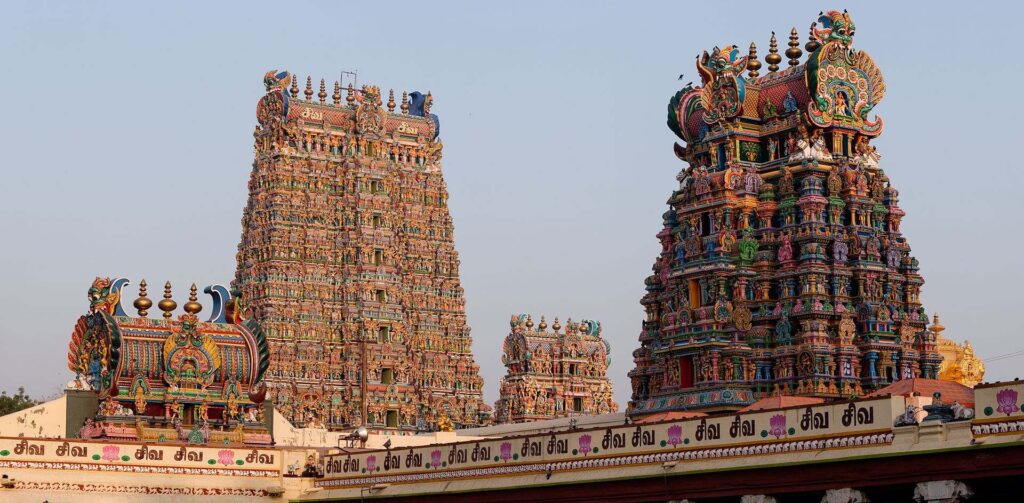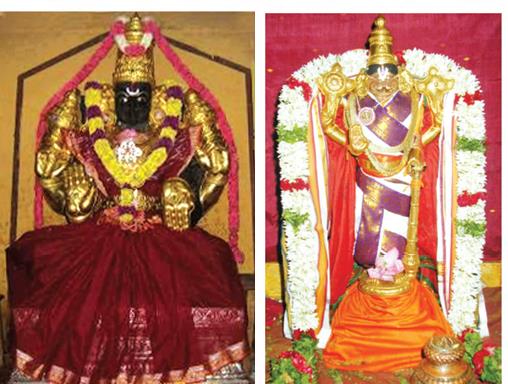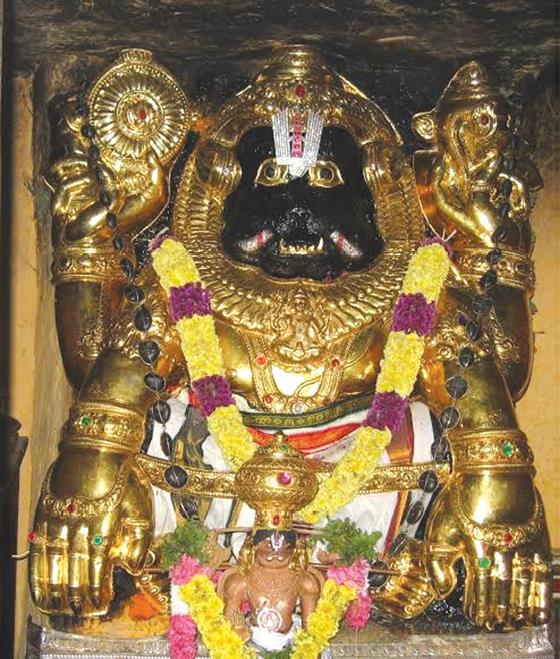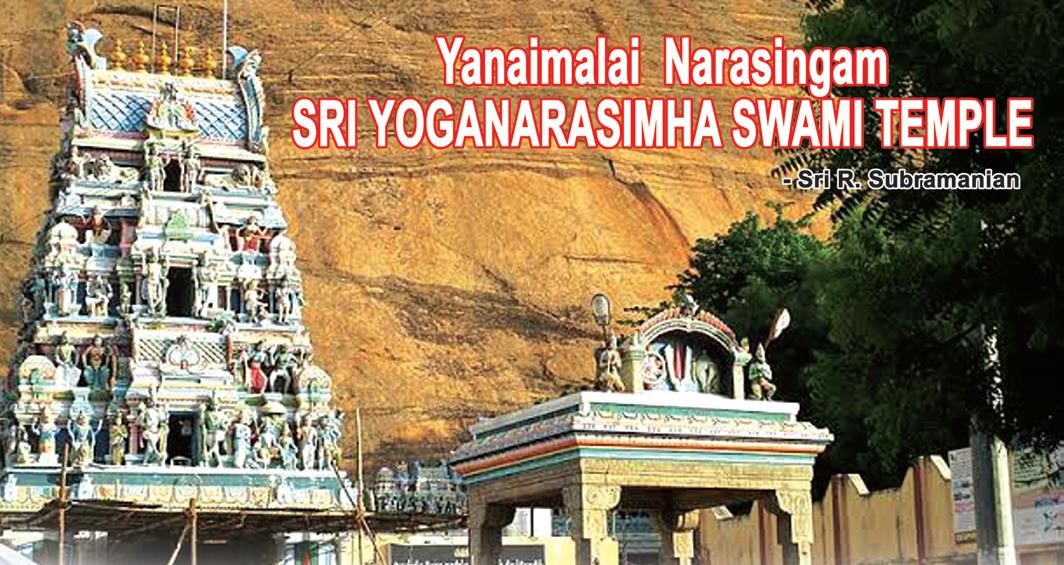Narasingam Sri Yoga Narasimha Swamy Temple
To put an end to the atrocities of evildoers and to defend His true devotees Lord Mahavishnu took as many as 24 avatars of which the most popular are the ten avatars called Dasavatara. In almost all Vishnu temples we can have dharshan of Dasavataras in a separate sannidhi.
Of the main ten avatars, Sri Rama and Sri Krishna avataras are hailed as poorna avataras and the temple of these avataras in our country is legion. Next to these avataras, Narasimha avatara of the Lord is very popular and Narasimha temples particularly in Andhra Pradesh and Karnataka are innumerable.
Though Lord Narasimha has taken abode in temples such as Ugra Narasimha, Yoga Narasimha, Prahlada Varada Narasimha and several other forms like Ahobilam Kshetra, Sri Lakshmi Narasimha temples are too many.
Yanaimalai Narasingam Temple
In Tamil Nadu, Sri Lakshmi Narasimha temples located in Sholingur, Parikkal, Singirikudi, Sevilimedu, Narasingapuram, and Velachery in Chennai are very popular.
The most popular Narasimha temple where the Lord appears as Yoga Narasimha is the one near Madurai City.

The very place where the cave temple of Sri Yoga Narasimha is situated is called Narasingam, a small village at the foothills of the massive rock called Yanaimalai just 8 km from the city of Madurai. Of the 108 Divya Desams, 18 are in Pandya country.
Of these 18, there are Divya Desams temples in Thirumalirumcholai known as Alagar Kovil at a distance of 20 Kms from Madurai and Thirumohur Sri Kalamega Perumal temple 10Kms from Madurai. Narasingam temple is located between Alagarkovil on the North and Thirumogur on the East.
It is believed that in 770 A.D. one Madurakavi also known as Maarankari who served as a minister under the Pandya king Parantaka Nedunchadayan (775-795) of the First Pandya Empire, commenced the construction of this temple and later the construction was completed with a Mukha Mantapam by his brother Maaran Eyhinan.
The Cave Temple
The temple has its puranic legend behind its inception.
Once, Sage Romasa did penance on the banks of Padma Sarovar (lotus tank pond) at the foot of Gajagiri (yanaimalai) and prayed to Lord Vishnu to give him darshan as Narasimha. As Narasimha appeared in his ugra (ferocious) form the rishis and devas were frightened by the intense heat of His fury and propitiated Him to calm down.
Prahlada and Sri Mahalakshmi rushed there, prayed, and pacified Sri Ugra Narasimha who calmed down and appeared to them as Yoga Narasimha, took abode in this kshetra as Yoga Narasimha and Sri Mahalakshmi also stayed here as Sri Narasinga Valli. The presence of the colossal rock running to more than a kilometer, serving as a natural backdrop to this impressive temple has its legend.
Gajagiri and Hasthigiri
According to Thiruvilayadal Purana which narrates the 64 leelas of Lord Sundareswara tells us that a Chola king sought the help of Jain monks to win the battle against a Pandya King. When the King implored Lord Shiva to save him, the Lord dispatched the Narasimha Asthra which turned the wild elephant into a massive rock.
Therefore, this rock is called Yanai Malai Tamil and is also known as Gajagiri and Hasthigiri, The rock resembles a crouching elephant.
Another Legend
There is another legend that tells that Lord Shiva took a holy dip in the Chakra Theertham here, worshipped Sri Yoga Narasimha, and got rid of his brahmahathiya dosham which afflicted him following his act of removing the head of Lord Brahma.
Therefore, it is believed that taking a holy dip in this theertham would absolve us of our sins.
The sprawling lotus pond on the right side of the temple arrests our attention with a lot of lotus flowers. The lotus pond, the gopuram, and the backdrop of the huge yanaimalai rock add charm and beauty to the temple. The entrance of the temple is adorned by a three-tier gopuram with five kalasas.
After the entrance, there is Maha mandapam followed by Artha mantapam and garbagruha. As we enter inside on our left is the separate south-facing sannidhi of Sri Mahalakshmi called Sri Narasingavalli Thayar in this temple. The gopuram and other mantapams belong to Pandya period.

Yoga Narasimha
The Yoga Narasimha form of Sri Narasimha Moorthy is closely associated with Sudarsana Chakra, the prominent weapon of the panchayudas of Lord Maha Vishnu. In Sudarsana idols, Sri Sudarsana Moorthy with four, eight, or 16 hands wielding various weapons is shown within a shatkona (six points) yanthra, and behind this idol Yoga Narasimha in the yogic posture wielding Sudarsana in all his four hands gives dharshan.
Yanaimalai Narasingam is the most famous Yoga Narasimha Temple in Tamil Nadu.

In the Yanaimalai temple, the sanctum is bursting with the glorious and imposing presence of Lord Yoga Narasimha majestically seated in yoga posture with both hands on His folded legs with yoga battam. The six feet tall majestic moorthi has been carved on the rocks and a sanctum is formed in front of it.
The upper hands wield Sanka and Chakra and the front hands are held on the slightly lifted knees. In front of the Moola moorthi is the ursavautsava idol of Sri Narasimha in standing posture with four hands. The upper hands hold Sanka and chakra while the front right hand is in abhaya mudra and the left hand rests on the mace.
Inscriptions
There are several Brahmi and Tamil inscriptions in this temple. Two of them speak of the gifts granted to the temple by Pandya king Srivallabha (1101-1124 AD).
Two more inscriptions refer to the conquest of Chola country by Sundara Pandya (1216-1238AD). There are also references to the presence of Vedic scholars in the village and the gifts of lands to them by kings.
Festivals
Narasimha Jayanthi is celebrated grandly in Yanamalai Narasingam Yoga Narasimha temple. On Maasi Magam day (February) Sri Kalamega Perumal from Thirumogur visits Narasingam for the Gajendra Moksha festival.
On every Swathi Nakshathra day, special thirumanjanam and poojas are performed.
On Saturdays, hundreds of devotees throng the temple. Devotees believe that a dip in the holy Padma Theertham and Dharshan of Yoga Narasimha will absolve us of our sins and that Lord Narasimha will bestow on us His abundant grace for health, peace of mind, and santhana baghyam.
Arulmigu Yoga Narasinga Perumal Thiru Kovil Location
Narasingam village is just 2Kms from Othakkadai, Madurai – Melur main road. Othakkadai at a distance of 8Kms from Madurai is the bus stop from where one can engage an auto and visit both Thirumogur (4Kms from Othakkadai) and Narasingam temple. One can visit this temple and be blessed.
Wiki Link for more information
Click here for Google Maps Location

